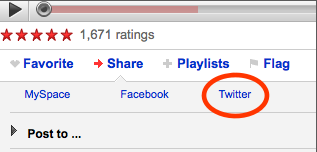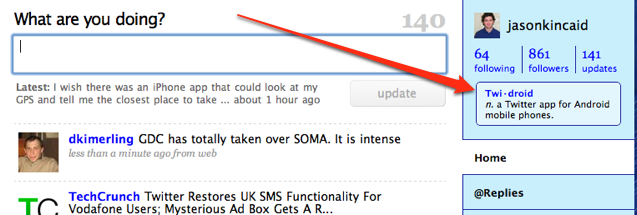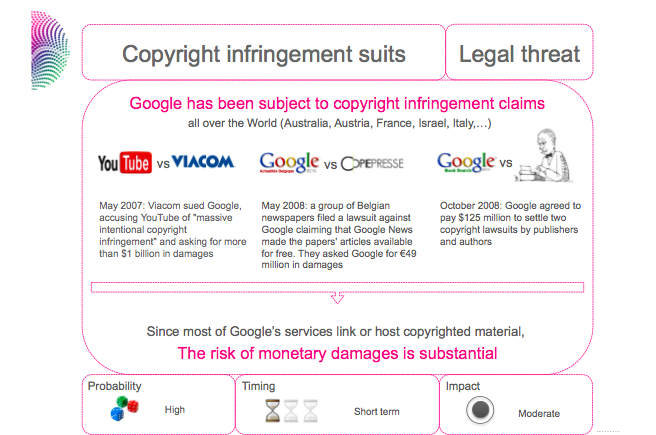The Latest from TechCrunch |  |
| Youth Bloggers Network Acquired By Teens In Tech Posted: 27 Mar 2009 07:00 AM PDT Teens In Tech, a blogging network founded by 16 year old Daniel Brusilovsky, has acquired the Youth Bloggers Network (YBN). YBN consists of a network of over 100 young bloggers, and was founded by Patrick DeVivo, who is also a young entrepreneur. The terms of the deal were not disclosed, but given how similar the networks are I suspect that if there was any monetary exchange it was very small - it sounds like the two networks are banding together to help establish traction. Teens In Tech is meant to offer teenagers a simple way to blog their thoughts in an atmosphere that is both safe and receptive to their ideas. The site launched back in August in a private alpha, and has yet to open signups up to the public (Brusilovsky says that the gates will temporally open this weekend, but that it will become private once more after that). While the company had initially planned to open to the public last winter, it is currently exploring building its own CMS, and is also working to establish an advertising program for its publishers. As I wrote when the site first launched, there doesn’t seem to be a whole lot of unique technology behind Teens In Tech - the site is essentially a multiuser WordPress install, with some custom tweaks like an RSS feed that pulls from all of the network blogs. That said, there is clearly a dedicated community of teens keen on blogging. I’m just not sure how Teens In Tech is going to build a viable business out of them - given how many free publishing platforms are available elsewhere, it’s going to be hard to get teens (who aren’t exactly swimming in cash) to pay to blog. And at scale it’s going to be hard for Teens In Tech to ensure that its safe community of teenagers stays a community of teenagers. Crunch Network: CrunchGear drool over the sexiest new gadgets and hardware. | ||||||||||||||||||||||||||||||||||||
| MyID.is Now In Public Beta, Aims To Become The Digital Certification Standard Posted: 27 Mar 2009 02:50 AM PDT
Additionally, the site offers (yet another) way to manage your online identity and doubles as a certified OpenID provider. The site has been in alpha testing for the past 8 months and as of yesterday entered into public beta. This is how it works: you register for a MyID.is Certified account on the website, and enter your personal details, which are later verified by the team (I’ll get to the issues with this later). They do this by cross-checking the name you submitted with the one on your credit card - they’ll charge a fee between $2 and $5 to verify that it is yours, similar to how Google checks your credit card details for an AdSense account - and by sending a 6-digit code to your postal address which you have to enter to verify your identity on their platform. Other than the small setup fee, the service is free of charge. You get a dedicated MyID.is URL, which looks like this: http://myid.is/charles.nouyrit.id (this is the one of founder and CEO Charles Nouÿrit) and you get some badges which you can place on your blog or social networking profile to show that your identity has been verified by the company (example). The platform also features a number of custom widgets, offering ‘endless possibilities’ to spread your online ID. It’s an ambitious project, and it’s always nice to see such an initiative coming from Europe. But the elephant in the room is of course the fact that MyID.is facing the humongous issue of having to convince people to effectively trust them with their private data, credit card details and physical address included (which they explicitly promise never to sell, evidently). I’m sure there are security measures in place, and Nouÿrit says they don’t keep the confidential information and never even gain access to it as it passes through to a sophisticated banking system, but that is really besides the point. People are still going to need to feel confident about signing up for the service, and I’m not sure how a tiny company based in London is going to be able to reach that level of trust worldwide. Nouÿrit counters by pointing to the fact PayPal needed a couple of years to be widely accepted too, which is a good point but not exactly a wildcard for MyID.is. There doesn’t seem to be a lot of competition for verifying your online identity across the globe, and the solutions we could dig up were fairly expensive. In the U.S., there’s Trufina and BeenVerified.com, and in Finland there’s something like NorthID.com (also see BankID in Sweden). How do you feel about the concept behind MyID.is Certified? Crunch Network: CrunchGear drool over the sexiest new gadgets and hardware. | ||||||||||||||||||||||||||||||||||||
| If Objects Could Talk They’d Say, “SendMeHome.” Posted: 27 Mar 2009 12:21 AM PDT
In his book Shaping Things, Bruce Sterling imagines a future where objects are tagged, tracked, and all tell their own stories. He calls these objects “spimes.” I read the book years ago, but it was the first thing I thought of when I visited SendMeHome. The site is wacky but brilliant. It lets you register any object with a unique code, which is printed out on a small sticker that you place on the object. The object can be anything from your wallet or iPhone to a beloved frying pan. Ostensibly, the purpose of doing this is that if you should ever lose the object, anyone who finds it can contact you through SendMeHome. By entering the code on the sticker, they can learn anything you’ve decided to share about yourself or the object, and can contact you anonymously. SendMeHome offers this service for free, but charges $3.99 for a pack of stickers. (It doesn’t get involved in actually getting your item back to you). The lost-and-found feature is the only practical reason you would use the service. But once you’ve attached a sticker to a favorite object and registered it on the site, there are other things you can do with it. You can tell a story about the object, pass it around, or put it on a mission. It is on its way to becoming a spime,. These spimes are “always associated with a story. . . . they are protagonists of a documented process,” as Sterling once described it. SendMeHome lets people create a very rudimentary version of a spime. Anyone who enters the code found on the SendMeHome sticker can add to the object’s story in a blog-like format which incorporates Google Maps, YouTube videos, and uploaded photos. For instance, here is the story of a disposable camera that was left on a bench in LA with instructions for passersby to take photo with it. (They did). And here’s another one of a bacon frying pan, which instructs people to cook their favorite bacon recipe in the pan, document it with photos, and pass it along to another bacon lover. Every object has a story which SendMeHome lets you unlock. There are flavors of the social game Akoha here, with its bar-coded cards and playful missions set in the real world. SendMeHome should be getting more social itself now that it has a Facebook app and has integrated its site with Facebook Connect. To encourage people to use its new Facebook app, it is putting up prizes worth $1,000 for whoever can create the SendMeHome stories on Facebook with the most followers by May 4. The company has been bootsrrapped with $50,000 from founders Andrew Lee and James Tamplin.
Crunch Network: CrunchGear drool over the sexiest new gadgets and hardware. | ||||||||||||||||||||||||||||||||||||
| Big Google Product Announcement Coming April 7 Posted: 26 Mar 2009 10:52 PM PDT
What will they announce this time? A good bet is Java on AppEngine, which we’d previously heard wouldn’t be announced until the I/O conference in May. But the product would be a good fit for Campfire One. Of course, it may also be something else entirely. We’ll attend (either because we’re invited or because we just show up) and live blog whatever it is that happens. Crunch Network: MobileCrunch Mobile Gadgets and Applications, Delivered Daily. | ||||||||||||||||||||||||||||||||||||
| Posted: 26 Mar 2009 10:08 PM PDT
Everybody’s doing it. Even YouTube has succumbed to Twitter mania. Below every video if you click on the “Share” link you will find three options: MySpace, Facebook, and now Twitter. You can expand the box for even more sharing options, but those are the main three and Twitter was just recently added. Clicking on the Twitter button opens a pop-up window that takes you to your Twitter account and fills in a Tweet telling your followers to “check out this video,” along with the title and URL. The URL is not shortened, but YouTube is working on that. (Youtube URLs are short anyway, so it is not a huge issue). Adding Twitter as one of the key sharing options is a no-brainer. Now, if they could actually embed the videos in the Twitter stream like you can on Facebook and MySpace, that would be something. YouTube announced some other tweaks today as well. The upload status bar is now fully rolled out. You can watch lectures and educational videos on YYouTube EDU, and it updated its mobile landing page and simplified the process of uploading a video from your phone to YouTube.
Crunch Network: MobileCrunch Mobile Gadgets and Applications, Delivered Daily. | ||||||||||||||||||||||||||||||||||||
| We Put Pepsi’s New Aquafina Product To The Test Posted: 26 Mar 2009 07:52 PM PDT
I’m concerned that Pepsi decided to promote its new “eco-friendly” product by proactively shipping, via Fedex overnight, 5 lb boxes of the water to press around the country. And then sending a second batch either in error or to reinforce the message. That’s not very eco-friendly (if anyone knows the carbon cost of sending these boxes, let me know, then multiply it by hundreds or thousands of press). It all seems a little wasteful. Anyway, after all this carbon spending and the general effort involved in sending me six bottles of water I never requested, I thought I should at least put the product to the test. I don’t drink bottled water myself, since it’s less safe than tap water and way too expensive (see the clip from Bullshit below). But Laguna, my 105 lb chocolate lab, loves bottled water. And she loves to chew on stuff. So we brought her in for a special assignment to test Aquafina’s new Eco-fina water in the TechCrunch Lab. She reluctantly agreed.
First off was the taste test. She doesn’t look particularly enthusiastic in the picture above, but once I started pouring, she was definitely into it. She didn’t even wait for it to hit the bowl:
So Laguna definitely like the taste of Aquafina water (she also eats dirt, and enjoys licking my feet). Next was the durability test. It took her about ten seconds to destroy the bottle, which isn’t good. Pepsi removed about half the plastic from the new bottles, and they clearly aren’t going to hold up to any kind of sustained attacked from a large, well-toothed canine:
Overall I’d say that Aquafina water is absolutely good enough for my dog to drink, and the bottles make fun albeit short-lived chew toys to distract her. Here’s that clip on just what you get with bottled water, if you’re interested: Crunch Network: MobileCrunch Mobile Gadgets and Applications, Delivered Daily. | ||||||||||||||||||||||||||||||||||||
| Capital Factory Gives Austin Its Own Startup Incubator Posted: 26 Mar 2009 05:55 PM PDT While many people in the tech world only make the trek to Austin, Texas once a year for SXSW, the city has a fairly sizable startup community. Now Austin is getting its own Y Combinator-esque program, dubbed Capital Factory. As with other similar programs, Capital Factory offers entrepreneurs a modest amount of funding in exchange for equity (the program is offering ‘up to $20,000′ in exchange for 5% of each startup). Capital Factory is also advertising ‘$20,000 in free stuff‘, which includes server usage, PR support, and legal help. But the real value from these programs comes from their associated mentors, who work with the startups to help them get on their feet, and help tap into their established networks of VCs and other entrepreneurs. The ten week long program culminates in a ‘Demo Day’ during which each startup will pitch their wares to VCs, press, and other entrepreneurs. Capital Factory joins a growing number of programs vying for the attention of eager new entrepreneurs. Aside from Y Combinator, which pioneered the idea, other incubators include TechStars (Boulder and now Boston), Start@Spark (Boston), LaunchBox Digital (Washington, D.C.), DreamIT Ventures (Philadelphia), and Shotput Ventures (Atlanta) Most of these are regional, but they still draw from the same pool of entrepreneurs (many of whom are willing to relocate temporarily if they get accepted to their preferred program). Recently we’ve heard of some shady tactics like exploding term sheets that are being employed as these programs compete for the same candidates. Crunch Network: CrunchGear drool over the sexiest new gadgets and hardware. | ||||||||||||||||||||||||||||||||||||
| Game Developers Conference 2009 Round-Up Posted: 26 Mar 2009 05:04 PM PDT
The news on everybody’s minds is OnLive, a games service which is roughly comparable to a streaming movie service like Netflix On Demand or what have you. The hardware is to be free, and it will support any USB- or Bluetooth-compatible controllers. Purchased games are run in datacenters (on state of the art hardware, we hope), which then push the content out to you. But they’re not sending game assets — they send a video image of the game as you play it on their machine. It sounds ridiculous, but with good, local servers they can get the ping under 10-20ms, at which point it is almost unnoticeable that the game you’re playing is actually a few cities away. Not everyone is so optimistic. We gave it a shot, and (my driving skills notwithstanding) had no trouble in the form of video artifacts, skipped frames, or lag. Impressive, but the proof of the pudding is in the launching, and when they can provide this level of latency and reliability to thousands of people scattered around the country simultaneously, then we’ll talk. After the demo, we spoke with a more technically-orientated booth guy, who said that between 3 and 4Mbit/s is what they’re aiming for with their 720p60 stream, and when I asked about tension with ISPs, he hinted cryptically that they had that under control. I just hope Comcast and the like haven’t “overbooked” their cable and fiber the way airlines do flights. Both Microsoft and Sony gave developers a boost, Microsoft in the form of a sleek new developer console and kit tools, Sony by dropping its devkit’s price significantly. Nintendo, as at E3, told us how well they were doing, revealed a couple new games, and demonstrated something ridiculous. Adding the capability to use SDHC cards is a welcome change, however. The 360 will be receiving a motion-based controller soon, bringing it up to speed nominally with the other consoles in that area. The Gametrak Freedom relies on a sort of ultrasonic sonar, with stereo detectors attached to the display. We gave it a try and it seemed to work decently; keep your eye on CG for video of yours truly flailing grotesquely at virtual tennis balls. Aside from the relatively far-reaching news I’ve mentioned, GDC is primarily a developer’s paradise. Indie game developers rub elbows with greats like Hideo Kojima and there are more talks, panels, and tutorials than we thought possible, or practical. We’re looking forward to E3 to see how some of these new technologies pan out in a more consumer-orientated environment. As for games themselves, we got to try out the DSi camera, Punch-Out!!! for the Wii, Fat Princess, and a few others. Lastly, if you or your spouse or young one is in the market for a little more rhythm, we’re running a contest to win a pre-release copy of Rhythm Heaven for the DS. For those of you reading this at or around GDC, we hope to see you at one of the many industry events that will be going on later. Crunch Network: CrunchBase the free database of technology companies, people, and investors | ||||||||||||||||||||||||||||||||||||
| New Microsoft Ads Point Out, Cough, High Cost Of Macs Posted: 26 Mar 2009 04:18 PM PDT They’ve got a point on the cost to feature ratio of Macs v. Windows machines in this new Microsoft ad. I have to say, these things are getting a lot better over time. And the price difference is the key weak point in the Apple product lineup. Mac fanatics couldn’t care less. But to a recession-beaten regular computer user, this message is right on the money. “I’m just not cool enough to be a Mac person,” the actress says after visiting an Apple store and not finding any laptops in her price range. See our coverage of other recent Microsoft ads here, here, here. Crunch Network: CrunchBoard because it’s time for you to find a new Job2.0 | ||||||||||||||||||||||||||||||||||||
| End-of-Quarter Layoffs Hit Amazon, IBM, Google, and The New York Times Posted: 26 Mar 2009 04:03 PM PDT With the end of the first quarter of the 2009 almost here, even the strongest companies companies are making last-minute layoffs to shave costs. Today, layoffs were announced across the tech sector, from IBM to Google to Amazon. The biggest layoffs came from IBM, where 5,000 people are losing their jobs in the U.S.. Amazon cut 210 people at three distribution centers in Nevada, Indiana, and Pennsylvania. Google also announced layoffs of 200 people from sales and marketing (so far, engineers have been spared). In all three cases, the job cuts amounted to roughly one percent of each company’s global workforce. The New York Times also announced a 5 percent cut of its It is not as if the payroll reductions will help save the quarter or even have a material impact on it. But the companies can point to the measures during their conference calls with investors and analysts and project the savings going forward. We’ve added the job cuts to our Layoff Tracker. To see who is hiring, check out our CrunchBoard.
Crunch Network: CrunchBase the free database of technology companies, people, and investors | ||||||||||||||||||||||||||||||||||||
| Posted: 26 Mar 2009 03:52 PM PDT  Microsoft's Steven Martin has ironically blown the whistle on an attempt at an "open" coalition that freezes out certain companies. Ironic in that Microsoft and IBM played this game years ago with the WS-I, an industry standards group that pointedly stonewalled Sun Microsystems' involvement before caving under media pressure. In a Google Groups post Introducing the Open Cloud Manifesto, Rueven Cohen describes an effort involving "several of the largest technology companies and organizations" to "draw a line in the sand." Microsoft's Steven Martin has ironically blown the whistle on an attempt at an "open" coalition that freezes out certain companies. Ironic in that Microsoft and IBM played this game years ago with the WS-I, an industry standards group that pointedly stonewalled Sun Microsystems' involvement before caving under media pressure. In a Google Groups post Introducing the Open Cloud Manifesto, Rueven Cohen describes an effort involving "several of the largest technology companies and organizations" to "draw a line in the sand." We are still working on the first version of the manifesto which will be published Monday, March 30th with a goal of being ratified by the greater cloud community. Given the nature of this document we have attempted to be as inclusive as possible inviting most of the major names in technology to participate in the initial draft. The intention of this first draft is to act as a line in the sand, a starting point for others to get involved. That being said this manifesto is not specifically targeting any one company or industry but instead is intended to engage a dialogue on the opportunities and benefits of fostering an open cloud ideology for everyone.As inclusive as possible? Not targeted at any one company? Engage in a dialogue? What a load of crap that is. It's the same back room cigar-smoke-filled scam of the good old days when Web Services first began its inexorable move to reshape computing. | ||||||||||||||||||||||||||||||||||||
| Posted: 26 Mar 2009 03:21 PM PDT
The California legislature is considering regulating the color of cars and reflectivity of paint to reduce the energy requirements to cool them. A presentation on the proposed legislation by the California Air Resources Board is below. The problem isn’t the color per se, but the reflectivity of the paint overall. And dark colors just don’t reflect well, so they are likely out. “Jet black remains an issue,” says the report. Anyone who’s ever entered a very hot car knows that it can be cooled down immediately by driving a few feet with the windows open, effectively neutralizing any color-caused heat issues before engaging the air conditioner. But whatever, black is evil. The new regulations would be phased in beginning in 2012, so if you want that black car, you better buy it soon. More on Autoblog and CrunchGear. And you thought that black Toyota Pious you bought made you such a good person. Think again, you tree hating energy slob. Luckily, black websites are still ok, even though they, too, use more energy.
Crunch Network: MobileCrunch Mobile Gadgets and Applications, Delivered Daily. | ||||||||||||||||||||||||||||||||||||
| Twitter Restores UK SMS Functionality For Vodafone Users; Mysterious Ad Box Gets A Refresh Posted: 26 Mar 2009 03:00 PM PDT Twitter has just announced that it has restored full SMS functionality to customers in the UK who are using Vodafone. While any Twitter user can submit updates via text message, for months only users in North America have been able to receive them (a key part of the service if you don’t have a smart phone). Other countries used to have this functionality, but Twitter began to cut them off after reporting that a single heavy UK user could cost up to $1000 in fees per year. From Twitter’s blog post:
For more on the new UK deal, check out our post on TechCrunch Europe. Also worth noting is the latest chapter in the story of Twitter’s mysterious sidebar box that may-or-may-not be an ad, some day. Two weeks ago Twitter introduced an unobtrusive box in the ride sidebar of user profiles, where it began to promote some of its own services (including Twitter Search). Three days ago, it began showing ads for third party services. One of these was for ExecTweets, a recently-launched aggregator of Tweets from high-ranking business exectuives that was built in part by Federated Media. Federated’s John Battelle wrote that the ad network was paying Twitter, but it was unclear if this was directly related to the promo appearing on Twitter’s homepage. And the other two apps being promoted - an iPhone client called Tweetie and a web app called Twittervision - weren’t paying a cent. Today Twitter appears to have swapped these promos out for new ones, which include Twidroid (a Twitter app for Android), twistori (a social experiment), and march tweetness (a Twitter service that revolves around the NCAA tournament).
Crunch Network: CrunchBase the free database of technology companies, people, and investors | ||||||||||||||||||||||||||||||||||||
| YouTube EDU Launches, So Go Learn Something Posted: 26 Mar 2009 02:44 PM PDT
The site is aggregating videos from dozens of colleges and universities, ranging from lectures to student films to athletic events. Some of this stuff is solid gold (the Stanford and MIT lectures are really good). Other content, not so interesting. Just a couple of days ago we covered Academic Earth, a site that aggregates useful educational content (”Hulu for education”). Both of these sites are great ways to spread learning. Crunch Network: CrunchGear drool over the sexiest new gadgets and hardware. | ||||||||||||||||||||||||||||||||||||
| Popular Songs On iTunes To Hit $1.29 On April 7 Posted: 26 Mar 2009 02:22 PM PDT  Thenew iTunes pricing scheme is set for an April 7 launch, says the Los Angeles Times. They do good work over there. Apple hasn't revealed this date publicly, but April 7 is supposedly what Cupertino is telling record labels. Remember: prices now top out at $1.29 for popular songs. Think Britney Spears—she's still popular, right?—Lady Gaga, anything with Auto Tune, etc. This country, I swear. (Although, let the record show, I do like Taylor Swift, which makes me a complete hypocrite and a half-idiot. And I'm not even talking about, "Wow, she's hot," I actually mean I enjoy her music.) Thenew iTunes pricing scheme is set for an April 7 launch, says the Los Angeles Times. They do good work over there. Apple hasn't revealed this date publicly, but April 7 is supposedly what Cupertino is telling record labels. Remember: prices now top out at $1.29 for popular songs. Think Britney Spears—she's still popular, right?—Lady Gaga, anything with Auto Tune, etc. This country, I swear. (Although, let the record show, I do like Taylor Swift, which makes me a complete hypocrite and a half-idiot. And I'm not even talking about, "Wow, she's hot," I actually mean I enjoy her music.) | ||||||||||||||||||||||||||||||||||||
| Support Radio: Internet Walkie-Talkie Concept Is Like Audio Twitter Posted: 26 Mar 2009 02:17 PM PDT  Designed to battle internet addiction, the Support Radio concept from designer Joe Malia is aimed at "partners, parents and kids struggling to cope with the non-involvement of an excessive computer user in the home." The idea is that, for instance, if your spouse is addicted to Facebook and/or Twitter, you record a message into your radio and then someone else on the other side of the world can hear your messages and respond back with advice. Designed to battle internet addiction, the Support Radio concept from designer Joe Malia is aimed at "partners, parents and kids struggling to cope with the non-involvement of an excessive computer user in the home." The idea is that, for instance, if your spouse is addicted to Facebook and/or Twitter, you record a message into your radio and then someone else on the other side of the world can hear your messages and respond back with advice. | ||||||||||||||||||||||||||||||||||||
| HotPads Drops Its Hot Maps On Vacation Home Rentals Posted: 26 Mar 2009 01:15 PM PDT
Just because your bank account might be light is no reason to cancel your vacation this year. There are alternatives to expensive hotels. Expensive summer home rentals. Actually, renting someone’s vacation home for two to three weeks is usually cheaper than a fancy hotel and you get a lot more room to spread out. But finding a vacation home to rent out can be a real chore. Sites like VRBO.com have great inventory, but they are not easy to navigate or search. You have to know the exact town you want to stay in because there is no way to search listings on a map. Enter Hotpads, the real estate site that is all about maps. It just added a “vacation” tab to its site, which lets you search for 20,000 vacation home rentals across the U.S. Results are plotted on a map, which is really convenient when you want to know how far away from the beach or the ski slopes the property is. Results can also be sorted by price and availability, which show up when you mouse over any given house icon. For instance, here is a search for Lake Tahoe vacation homes on HotPads (screenshot above), and here is what you get on VRBO (below). It is just alist of towns. Not very helpful, especially if you are traveling to somewhere you are not familiar with. I don’t know why all real estate sites don’t just default to a map interface for search results. Sometimes it is an option, but usually you just get a mind-numbing list you have to scroll through. Homeaway, the Austin company which owns VRBO and several other vacation rental sites, should think about adopting a map interface across all of its sites. It has much more inventory—124,000 vacation homes—but they are so hard to find. For a company which raised $250 million last November, you’d think it could do better than that.
Crunch Network: CrunchBase the free database of technology companies, people, and investors | ||||||||||||||||||||||||||||||||||||
| Live Unveiling Of The Tesla Model S Sedan Posted: 26 Mar 2009 12:30 PM PDT Innovative electric-car startup Tesla is unveiling the latest addition to its lineup this afternoon in Southern California. The sedan is meant to serve as a more affordable entry to the Tesla lineup that will appeal to the mainstream, with a ticket price of around $50,000 (as opposed to well over $100,000 for the Tesla Roadster). Current estimates peg release of the car in late 2011.   Earlier today Digg’s Kevin Rose leaked a number of photos of the car (which has been kept tightly under wraps until now). The car apparently features a very large touchscreen in the center console, as well as a digital display that is possibly touch-sensitive in the dash. Rose appears to have made the Flickr accounts he originally posted the photos to private, but they have been copied to a number of other sites. The video feed should be live by 12:45 PM PST Update: It looks like Ustream had trouble with its feed, but here are some details, via Jason Calacanis’s Twitter stream.
Crunch Network: CrunchBase the free database of technology companies, people, and investors | ||||||||||||||||||||||||||||||||||||
| What Could Go Wrong With Google: The Slideshow Posted: 26 Mar 2009 11:09 AM PDT Why Could Google Die… View more presentations from Ouriel Ohayon. Want to know everything that could possibly go wrong with Google? Well, you can read the risk section of its latest SEC filing, but that’s a snore. Or you can flip through the slides above, which were put together by French consulting firm FaberNovel. They were the ones who gave us the hugely popular slideshow, “Everything you always wanted to know about Google . . . but were afraid to ask”. This one is titled more morosely, “Why could Google die . . . maybe not now, but tomorrow.” I wouldn’t be picking out caskets just yet, but the slideshow does provide a convenient cheat sheet for most of the major threats that Google faces. It quickly goes through them, including the threat of antitrust and copyright infringement litigation, a massive privacy disaster, hiring and retention issues, disruption from new startups. There is even a nice slide listing Google’s 12 main weaknesses, along with a visual assessment of the probability, timing, and impact of each scenario. Of course, chances are that it doesn’t include the one threat that will get Google in the end. (I don’t know what it is either, but I am a big believer in black swans). Below are some of the key slides.
Crunch Network: CrunchGear drool over the sexiest new gadgets and hardware. | ||||||||||||||||||||||||||||||||||||
| Get Ready For Java On AppEngine Posted: 26 Mar 2009 09:56 AM PDT
Java applications are extremely popular, particularly for business applications, and it is one of the internally supported languages at Google. In fact, late last year a startup called Stax Networks launched that billed itself as an “AppEngine for Java.” Don’t feel too bad for the startup, however, they’ve said from the beginning that they expected Google to enter the Java market sooner rather than later. Java continues to be one of the most popular programming languages, and is a natural next step for Google. And AppEngine has been a highly successful product, at least from a press standpoint - the Obama Administration has embraced it along with all things Google. Crunch Network: MobileCrunch Mobile Gadgets and Applications, Delivered Daily. |
| You are subscribed to email updates from TechCrunch To stop receiving these emails, you may unsubscribe now. | Email delivery powered by Google |
| Inbox too full? | |
| If you prefer to unsubscribe via postal mail, write to: TechCrunch, c/o Google, 20 W Kinzie, Chicago IL USA 60610 | |

 Digital certification platform
Digital certification platform 


 Google is holding one of its occasional “Campfire One” events for developers on April 7. These events, which are held outside on the lawn at Google Headquarters, have always included big product announcements in the past. At a
Google is holding one of its occasional “Campfire One” events for developers on April 7. These events, which are held outside on the lawn at Google Headquarters, have always included big product announcements in the past. At a 

 We cover tech news here at TechCrunch, so I was surprised to see a 5 lb overnight shipment arrive from Pepsi containing three half liter bottles of Aquafina water. The reason for the special delivery? The company is launching a new plastic bottle that contains half the plastic content of the old bottles. Less plastic = less landfill weight, less carbon, less bad stuff in general, they say.
We cover tech news here at TechCrunch, so I was surprised to see a 5 lb overnight shipment arrive from Pepsi containing three half liter bottles of Aquafina water. The reason for the special delivery? The company is launching a new plastic bottle that contains half the plastic content of the old bottles. Less plastic = less landfill weight, less carbon, less bad stuff in general, they say. 















 Here’s a juicy rumor (if you’re a geek, this is good stuff): A source tells us that
Here’s a juicy rumor (if you’re a geek, this is good stuff): A source tells us that
No comments:
Post a Comment